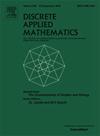覆盖数的某些图族
IF 1
3区 数学
Q3 MATHEMATICS, APPLIED
引用次数: 0
摘要
我们定义覆盖的一个图G的图类P的最小数量的图表类必须覆盖边缘的G的一篇论文中获取灵感Harary et al。(1977),我们找到一个精确的公式,封面的图类{G∣χ(G)≤f(ω(G))}引入函数f.After这个,我们建立一个链之间不平等的五个数字,一个由类{G∣χ(G) =ω(G)},完美的类图,广义分裂图,共单极图,最后由二部图得到覆盖数。我们证明了在每个不等式处,两边的差可以任意增大。证明了单极图的覆盖数不能用色数或团数来表示。本文章由计算机程序翻译,如有差异,请以英文原文为准。
Cover numbers by certain graph families
We define the cover number of a graph by a graph class as the minimum number of graphs of class required to cover the edge set of . Taking inspiration from a paper by Harary et al. (1977), we find an exact formula for the cover number by the graph classes for all non-decreasing functions .
After this, we establish a chain of inequalities between five cover numbers, the one by the class , by the class of perfect graphs, generalized split graphs, co-unipolar graphs and finally the cover number by bipartite graphs. We prove that at each inequality, the difference between the two sides can grow arbitrarily large. We also prove that the cover number by unipolar graphs cannot be expressed in terms of the chromatic or the clique number.
求助全文
通过发布文献求助,成功后即可免费获取论文全文。
去求助
来源期刊

Discrete Applied Mathematics
数学-应用数学
CiteScore
2.30
自引率
9.10%
发文量
422
审稿时长
4.5 months
期刊介绍:
The aim of Discrete Applied Mathematics is to bring together research papers in different areas of algorithmic and applicable discrete mathematics as well as applications of combinatorial mathematics to informatics and various areas of science and technology. Contributions presented to the journal can be research papers, short notes, surveys, and possibly research problems. The "Communications" section will be devoted to the fastest possible publication of recent research results that are checked and recommended for publication by a member of the Editorial Board. The journal will also publish a limited number of book announcements as well as proceedings of conferences. These proceedings will be fully refereed and adhere to the normal standards of the journal.
Potential authors are advised to view the journal and the open calls-for-papers of special issues before submitting their manuscripts. Only high-quality, original work that is within the scope of the journal or the targeted special issue will be considered.
 求助内容:
求助内容: 应助结果提醒方式:
应助结果提醒方式:


